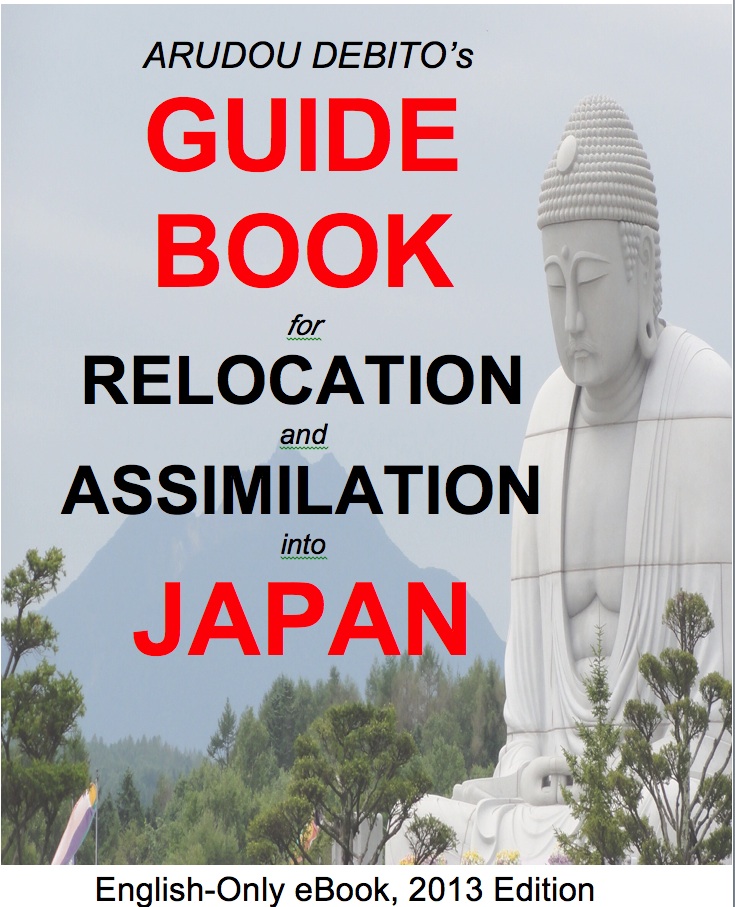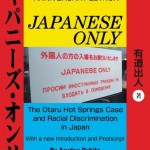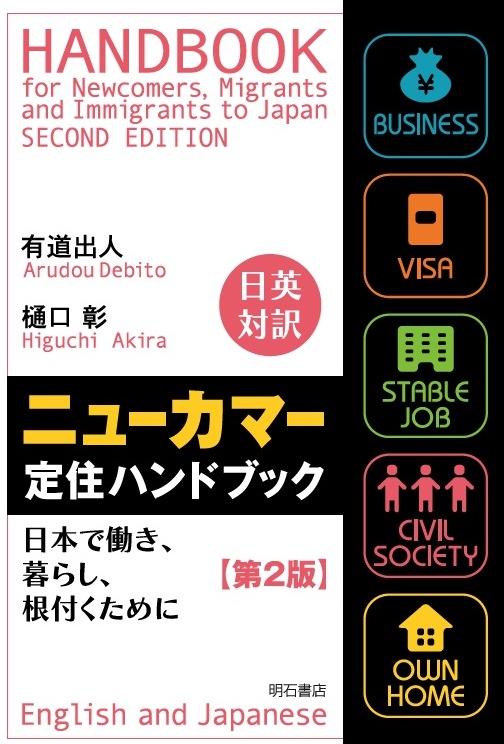mytest
Books, eBooks, and more from Dr. ARUDOU, Debito (click on icon):





![]()


UPDATES ON TWITTER: arudoudebito
DEBITO.ORG PODCASTS on iTunes, subscribe free
“LIKE” US on Facebook at http://www.facebook.com/debitoorg
https://www.facebook.com/embeddedrcsmJapan
http://www.facebook.com/handbookimmigrants
https://www.facebook.com/JapaneseOnlyTheBook
https://www.facebook.com/BookInAppropriate
If you like what you read and discuss on Debito.org, please consider helping us stop hackers and defray maintenance costs with a little donation via my webhoster:

All donations go towards website costs only. Thanks for your support!
Hi Blog. Here’s another one of Reuters’ in-depth reports (I say “another” because they did an excellent on Japan’s “Trainee” Visa system as “sweatshops in disguise” back in 2014) on Japan’s deadly Detention Centers, aka Gaijin Tanks, where people wait indefinitely for refugee status or deportation (and, according to Amnesty International, are subjected to extortion and physical abuse, because Gaijin Tanks are not officially “prisons”, and are not subject to the same incarceration oversight that actual Japanese prisons get). So what happens? People die. Reuters below has done some investigative journalism that more news agencies should be doing. Be sure to visit the link to the Reuters site as well in order to see some good stats in graphic form, not to mention related articles. Dr. ARUDOU, Debito
//////////////////////////////////////////
Death in Detention
Grim toll mounts in Japanese detention centers as foreigners seek asylum
By Thomas Wilson, Mari Saito, Minami Funakoshi and Ami Miyazaki
Reuters, Filed March 8, 2016, 2:45 p.m. GMT Courtesy of JH.
http://www.reuters.com/investigates/special-report/japan-detention/
Photo Caption: Niculas Fernando was in Tokyo to see his son and sit out potentially violent elections at home. The Sri Lankan’s death, in a cell monitored around the clock, reveals fatal flaws in a system stretched by record numbers of asylum seekers.
TOKYO – Niculas Fernando died at a Tokyo immigration detention center sometime between 9:33 a.m. and 10:44 a.m. on November 22, 2014, according to the coroner.
But it wasn’t until shortly after 1 p.m. that day that guards realized something was badly wrong – even though Fernando had been moved to an observation cell monitored via closed-circuit television after complaining of sharp chest pain.
An inmate had to alert the guards before they rushed into Fernando’s cell and tried to revive him. They found him lying face down on a mattress stained with his urine. He was lifeless.
A devout Catholic from Sri Lanka, Fernando had come to visit his son, who lives in a Tokyo suburb where he works in a restaurant kitchen. He was the fourth person to die in Japan’s immigration detention system in 13 months. In total, 12 people have died in immigration detention since 2006, including four suicides. In 2015, 14 detainees tried to kill or harm themselves at the detention center where Fernando died, according to data from the facility.
A Reuters investigation into the circumstances surrounding Fernando’s death, including dozens of interviews with detainees, immigration officials and doctors, revealed serious deficiencies in the medical treatment and monitoring of Japan’s immigration detention centers. Guards with scant medical training make critical decisions about detainees’ health. Doctors visit some of the country’s main detention centers as infrequently as twice a week. And on weekends there are no medical professionals on duty at any of the immigration detention facilities, which held more than 13,600 people in 2014.
RELATED CONTENT
Slideshow: Inside Japan’s immigration lock-up
Foreign workers power Subaru’s U.S. boom
Three of the four deaths in detention between October 2013 and November 2014, including Fernando’s, occurred when there were no doctors on duty. Like Fernando, another one of the detainees died while in an observation cell.
Japan’s immigration system is under increasing strain. As a torrent of refugees pours into Europe, Japan also has record numbers of people landing on its shores in search of refuge. As of June last year, it had 10,830 asylum applications under review – small by Europe’s standards, but a new high for Japan, a nation that has long been reluctant to take in outsiders.
In February, more than 40 detainees went on hunger strike at a facility in Osaka to protest their conditions [As they did in 2010, to little change — Ed.]. Their main complaint: Poor medical care.
The system’s oversight, too, is limited. Members of the watchdog body tasked with monitoring Japan’s 17 detention centers are appointed by the justice minister, who oversees the detention system. The findings of the watchdog are edited by the Justice Ministry before being made public, and the ministry has failed to act on repeated recommendations for improving medical care, say its members.
“I wanted to shout at them when I heard that guards left him alone for such a long time,” said Tooru Tsunoda, a doctor and vice chairman of the watchdog body that monitors the center where Fernando died. A report by the oversight group said guards “misjudged the seriousness” of Fernando’s condition. By not sending him to hospital immediately, the report found, they “missed opportunities to avoid his death.”
Report by immigration detention watchdog body on Niculas Fernando’s death
Justice Minister Mitsuhide Iwaki said the reports he received showed that in all four deaths, “appropriate medical steps” had been taken. “I do not acknowledge there were problems in the responses or the medical care provided.”
Fernando, who ran a travel agency back in Sri Lanka specializing in pilgrimages, hadn’t seen his son George for eight months when he reached Japan. Before he left home, he visited the many churches in his coastal hometown of Chilaw and “prayed for 24 hours,” said his wife, Magret.
A framed picture of Fernando sits on a table in the home where he and Magret lived from the time they wed in 1983. They had fallen in love and married within a month, even though Fernando’s family had initially opposed the union because Magret was nine years his elder.
The day before he died, Fernando called Magret from a payphone for inmates in the detention center. “He was not ill,” she said.
Sitting on a sofa and weeping quietly, she recalled Fernando’s last words before boarding the plane for Japan: “I’ll come back. Look after the children.”
He never returned. In fact, Fernando never made it through immigration at Tokyo’s Haneda Airport.
George and his wife waited in the arrival hall for Fernando after his plane landed at around 11 p.m. on Nov. 12. At 2 a.m. they learned Fernando had been detained by immigration officials who did not believe he was a genuine tourist.
“We would have loved to hear our father’s voice, but they didn’t give him the chance to talk to us,” said George, 27, speaking in Sinhalese through an interpreter at his apartment.
Two days later, George got to see his father. They met in a small room at Haneda Airport, separated by a glass partition.
“We couldn’t touch or hug,” said George.
George and his two brothers portray their father as a devoted family man who prayed daily, never drank and often took his family with him on work trips around Sri Lanka and India.
“He’d pray for at least an hour every morning, bowing down,” said his eldest son, Jerad, standing outside the home of a relative in a village near Chilaw. “His knees were black from the marks made from praying.”
One family photo shows Fernando playing a guitar as Catholic pilgrims dance behind him during a 2012 tour of churches in the north of Sri Lanka. George recalls his father joining a peace mission to a Tamil Tiger-controlled area in the late 1990s led by Bishop Malcolm Ranjith during Sri Lanka’s civil war.
Fernando “voluntarily joined our group and went as part of our pilgrimage,” Ranjith, who is now archbishop of Colombo, told Reuters. He described Fernando as “a very pious person.”
Fernando also was active in one of Sri Lanka’s main political parties, and that background may be key to understanding a surprising decision he made during his detention – to ask for asylum.
George said his father was a supporter of the United National Party (UNP), which now heads the ruling coalition in Sri Lanka, and had been the target of political violence in the past. With speculation growing that national elections were imminent, Fernando timed his visit to Japan so he could sit out the vote and escape any potential violence, George said.
But facing deportation after his arrest at Haneda Airport, Fernando decided to seek asylum, which would have allowed him to stay in Japan while his request was processed. He was going to return home once any election-related violence had subsided, his son said.
Elections in Sri Lanka were formally announced on Nov. 20. Fernando died two days later, before he could file the asylum papers, George said.
George and his Sri Lankan wife have been seeking asylum themselves in Japan for almost two years. A copy of his application says George faced death threats from political rivals when he worked for the UNP, which was in opposition at the time he sought asylum.
Asylum applications have jumped more than six-fold since Japan altered its immigration rules in 2010. The change allowed asylum seekers to obtain six-month renewable work permits while their applications are reviewed. But Japan is sparing when it comes to granting asylum: Only 27 people were approved in 2015.
The rule change, combined with Japan’s chronic labor shortage and strict immigration policy, has spawned a system of backdoor immigration, as Reuters illustrated last year in an article detailing Subaru’s heavy reliance on asylum seekers who toil in the factories that supply it with car parts.
Five days after arriving, Fernando was transported from a lock-up at the airport to the Tokyo Regional Immigration Bureau, a tower block overlooking the docks and a waste-incineration plant. A one-stop shop for visa renewals, asylum interviews and deportation orders, the complex also serves as a detention center for up to 800 people.
Fernando was placed in a cell in G-Block with two other detainees, from China and Peru. Fellow detainees described him as a serious man obsessed with cleanliness.
On the Saturday morning Fernando died, James Burke, a Canadian in the adjacent cell, was awakened by the Sri Lankan’s cries. It was around 7 a.m. Noise travels easily on the block and Fernando was in obvious pain, Burke said. “He was moaning and moaning and moaning.”
Fernando’s Peruvian cellmate called the guards and told them the Sri Lankan wanted to go to the hospital because his chest was hurting. The guards refused, saying the hospitals were closed on Saturdays, according to Burke and two other detainees who witnessed the events and asked not to be named.
At least two hospitals within a few miles of the detention center are open around the clock on weekends, including Saiseikai Central Hospital, where Fernando’s body would be taken later that day. Naoaki Torisu, a senior Justice Ministry official who oversees immigration detention, declined to comment on what specifically the guards told Fernando.
“His symptoms didn’t seem that serious,” Torisu said. “If his condition had worsened, we would have called an ambulance or taken him to hospital without hesitation.”
At 7:30 a.m., guards measured Fernando’s pulse and blood pressure, according to an internal report by the Tokyo Regional Immigration Bureau that was reviewed by Reuters. They found no abnormality, Torisu said.
But Fernando soon called for the guards again, this time more loudly. “He’s in real discomfort,” recalled Burke, who was being held at the time for overstaying his visa and is now on provisional release from immigration detention. “He was begging them, ‘I’m a Christian and I wouldn’t lie. I need to go to hospital or I’m going to die.’”
Just before 8 a.m., guards led Fernando to a room to check his condition. A report by the national Immigration Bureau, which is part of the Justice Ministry, said the guards “could not grasp the seriousness” of the situation because another Sri Lankan detainee who was acting as an interpreter did not translate Fernando’s words accurately. But the Justice Ministry’s Torisu told Reuters the guards did understand what Fernando was saying.
When the Sri Lankan returned to his cell a short while later, he looked relieved, said Burke. He gathered his Bible and clothes. “You could see it in his face – he was getting his stuff, thinking he would get help.”
But Fernando wasn’t taken to hospital. At 8:16 a.m., guards moved him to an observation cell fitted with closed-circuit television for around-the-clock surveillance of detainees who are ill, unruly or have tried to harm themselves.
Around 9 a.m. Fernando again called the guards from the cell. They told him to wait until the morning roll call was over, said Burke and two other detainees.
At 9:22 a.m., Fernando washed his hands and appeared to vomit. He then lay face down on a futon, according to the Tokyo Regional Immigration Bureau report on his death. At 9:33 a.m., he stopped moving.
A few minutes later, a guard brought a television to Fernando’s cell. He called out but Fernando didn’t respond. Thinking the Sri Lankan was asleep, the guard didn’t check to see if he was all right, the report said. For the same reason, guards did not check Fernando for the next several hours.
Immediately after cell doors opened at 1 p.m. to allow detainees out for the afternoon break, the Sri Lankan who had interpreted for Fernando hurried to the observation cell. Fernando’s breakfast – the standard white bread, jam and boiled egg – lay untouched. Fernando wasn’t moving. His body was cold.
Alerted by the detainees, guards rushed into the observation cell. It was 1:03 p.m. – three and a half hours since Fernando had last shown any signs of life.
A guard performed CPR on Fernando, but it was too late.
An ambulance was called and his body was carried out of G-Block on a stretcher, his face uncovered, two detainees said. Two hours later, he was pronounced dead. He was 57 years old.
Koichi Uemura, a coroner asked by the national Immigration Bureau to write an in-depth autopsy report on Fernando’s death, told Reuters he was allowed to view the video footage of the Sri Lankan in the observation cell. He said it was possible to tell from the images that Fernando was struggling and moaning before he lay down in the cell.
Uemura said he was asked to compile a report after the Immigration Bureau had investigated Fernando’s death and found that “there was quite a high possibility that (the detention center) did not provide adequate medical care, and that his illness got worse because he was left unattended.” A doctor at the Tokyo Medical and Dental University who performs autopsies for the police and courts, Uemura stopped short of saying that Fernando’s death could have been avoided if guards had taken him to hospital.
The Justice Ministry rejected a public disclosure request by Reuters to view the video footage of the observation cell, citing privacy reasons.
Since 2010, the Immigration Detention Facilities Visiting Committee – the watchdog body – has repeatedly called for improvements to medical care at detention facilities. Six current and former members of the 20-person oversight body told Reuters that key recommendations have not been implemented.
Inmates voice a similar grievance. In two handwritten letters, the hunger strikers at the detention center in Osaka complained about limited access to doctors and said guards without medical training were making judgment calls about the health of detainees.
Their protest didn’t impress the authorities. Tomohisa Takayama, a spokesman for the Osaka Regional Immigration Bureau, said there was no “rational reason” for the complaints, and that the hunger strike ended after five days.
In May, a former member of the watchdog wrote to then-Justice Minister Yoko Kamikawa calling for full-time doctors at detention facilities, better monitoring of detainees who are unwell and improved psychiatric care.
But the watchdog lacks teeth. It doesn’t perform surprise inspections. Its visits to detention centers are pre-arranged, and its members are escorted by immigration officials.
There has been little change since the deaths. Guards have been given “fresh instructions to call ambulances” in situations where they are having trouble “making judgments,” said the Justice Ministry’s Torisu. And two guards are being trained as assistant nurses in the entire detention system, which on Nov. 1 last year was holding 1,070 inmates.
It is “probably insufficient” that there are no doctors on duty at weekends, but that doesn’t mean medical care is lax, said Torisu.
On Nov. 22, the day Fernando died, George got a call from a family friend. “He asked me to calm down, to sit down,” George recalled, his eyes filling with tears. “He told us my father had passed away… I asked God why he took my father.”
The next day, George tracked Fernando’s body to a police station near the detention center. Officers there tried to stop him from opening the white body bag that contained his father’s body.
OBSCURED: Large sections of an official report on Niculas Fernando’s death that was released to Reuters were redacted. Click here to view the report. Source: Justice Ministry, Japan
“But I opened the bag,” he said. “I asked them if they were investigating my father’s death. They said they were, and when they had the report they’d tell me.”
George has never received any of the reports on his father’s death. On Dec. 19, almost a month after he lost his father, George received the death certificate. It didn’t contain the answer he’d been seeking: Cause “unknown,” it said.
That same day, Fernando was cremated about three miles from the detention center where he died. His family had hoped for a Catholic burial in Chilaw, but could not afford to fly his body home. His third son, Jude, who traveled to Japan for the funeral, is also now seeking asylum.
It would be another three months before Fernando’s family learned from Sri Lanka’s Foreign Ministry that he had died of a heart attack.
“I can’t believe that I lost my father,” said George. “Japan’s immigration authorities must take responsibility for my father’s death.”
The Justice Ministry has not made public the findings of the investigation into the case nor released them to Fernando’s family.
In response to a public disclosure request, Reuters received a copy of the national Immigration Bureau’s report from March last year. It was heavily redacted. Under a section titled “Problems,” every line had been blacked out.
===================================
SUB-ARTICLE
Death, drugs and detention
By Minami Funakoshi, Thomas Wilson, Ami Miyazaki and Mari Saito
In the 13 months before Niculas Fernando died in a Japanese immigration detention center in 2014, three other men suffered the same fate.
• Anwar Hussin, 57, a Rohingya from Myanmar, died on Oct. 14, 2013, after suffering a stroke while being held at the same detention center as Fernando.
• Saeid Ghadimi, a 33-year-old Iranian, choked on food and died on March 29, 2014, at the East Japan Immigration Center in Ibaraki prefecture, a sprawling complex set among rice paddies northeast of Tokyo.
• Flaubert Lea Wandji, a 43-year-old Cameroonian, died at the same center the next day, most likely due to acute heart failure.
The names of Ghadimi and Wandji, and many of the details of their deaths, have not been previously reported.
Like Fernando, Wandji died after being moved to an observation cell so his condition could be monitored. But the guards failed to grasp the need to take Wandji to hospital, the watchdog committee that monitors Japan’s detention centers said in a report last March to the national Immigration Bureau, which is part of the Justice Ministry. The report was reviewed by Reuters.
NO PROBLEMS: Justice Minister Mitsuhide Iwaki said ‘appropriate medical steps’ were taken in the case of all four men who died in immigration detention in the space of 13 months. REUTERS/Issei Kato/Files
The watchdog report drew attention to what it said was the heavy prescription of drugs to detainees. At the time he died, Ghadimi had been prescribed 15 different drugs, including four painkillers, five sedatives – one a Japanese version of the tranquilizer Xanax – and two kinds of sleeping pills, the report said. At one point during his incarceration, he was on a cocktail of 25 different pills.
“It is not an exaggeration to say he was in a so-called ‘drugged-up state,’” Teruichi Shimomitsu, a doctor and retired member of the watchdog body, wrote in a letter last May to then-Justice Minister Yoko Kamikawa.
Naoaki Torisu, a senior Justice Ministry official responsible for overseeing immigration detention centers, said parts of the committee’s report were “unclear.”
“Detainees take pills prescribed according to their medical needs,” he told Reuters. “I cannot grasp the exact intent behind the committee’s statement.”
Two psychiatrists cited in a November 2014 national Immigration Bureau report said the Iranian’s medications did not cause him to choke.
The prescription of sedatives and antidepressants is common in Japan’s detention centers, say doctors and detainees. Some inmates told Reuters they were given sedatives after arguing with guards or other detainees. Others said they became dependent on the drugs as they faced indefinite detention.
Checks are needed to ensure doctors do not prescribe “massive amounts” of sedatives to keep “rebellious” detainees quiet, Shimomitsu wrote in his letter to then-Justice Minister Kamikawa.
The Justice Ministry’s Torisu disputed that sedatives were used to pacify troublesome detainees. “Psychiatrists prescribe them because they are deemed medically necessary,” he said.
—————
ENDS
Do you like what you read on Debito.org? Want to help keep the archive active and support Debito.org’s activities? We are celebrating Debito.org’s 20th Anniversary in 2016, so please consider donating a little something. More details here.
21 comments on “Reuters: Death toll mounts in Japanese Detention Centers (aka “Gaijin Tanks”) as NJ seek asylum and are indefinitely detained and drugged”
This is a sickening ongoing saga that defies belief! But I wonder about the drugs: are those detainees forced to take the medications? Are they literally held down and have the pills forced down their throats or injections forced on them? Or are they passively swallowing whatever is given them?
Nothing new here this is old news again, another NJ dies and Japan doesn’t give a damn!
Institutionally racist Japan can literally kill non-Japanese who enter Japan, and despite it being an open secret amongst the international community, they get a free pass, and we are forced to endure patronizing statements such as ‘Japan is a country of law’, ‘Japan is a modern country’, ‘Japan is a global partner’ and ‘Japan shares our values’.
It would be funny if people weren’t actually being killed.
In other news, Abe’s invited Mugabe to Tokyo (again! See, way to share those western values Shinzo! Attaboy!). I’d guess that he can get not only great economic advice about inflation, but also about police state dictatorship and human rights suppression from Mugabe too!
http://www.japantimes.co.jp/news/2016/03/07/national/politics-diplomacy/abe-arranging-mugabe-92-visit-japan-late-march-summit-ahead-kenya-ticad/
Seriously, which country is Abe’s Japan becoming more similar to?
The USA or Zimbabwe?
Abe + Mugabe is great news- it supplies a one liner to which J apologist have no answer: “Shinzo Abe? Mugabe’s friend”.
A 21st century update of “Tojo? Oh yeah, Hitler’s mate” was in need as the younger generation may not be aware of who Tojo was.
Abe’s return to pre war values is coming true.. and tarring Japan’s image badly. Although its been ging on for years on the quiet, e.g. GOJ’s ties to the Myanmar junta, Fujimori etc.
They just can’t seem to kick that fascist groove thang addiction.
reality in Japan is clouded by ideology and mythology. Finding truth, embracing truth, expressing truth becomes impossible, because it will always offend somebody — and that is not done in Japan
I read the article on the JT last week. I just can’t believe that there are some idiots who are making a pathetic defense of government for an ill treatment of detainees. Go to Facebook and check out comments in the post. You can see a couple of disgruntled posters beating down the victims like dead horse. Couldn’t find more disgusting and sadistic than that.
When inmates from 3rd-world countries complain about lack of medical care, you know you have a problem. Many of these inmates are asylum seekers from 3rd-world, war-torn countries, who’ve probably never received adequate medical care in their life. When THEY start complaining about inadequate medical care (while being detained in a 1st-world country), you know you have a problem.
But as always, Japan never wants to face these issues head-on. Let’s sweep everything under the carpet and pretend we’re a really advanced country. I think Japan needs a WikiLeaks.
Horrified! Do they just snatch people as they enter at the airport? For what kind of offences, real or imaginary?
I haven’t seen any mention on Debito.org about potential amendments to the Immigration Control and Refugee Recognition Law, nor the plight and death of Wishma Sandamali, so allow me to dive in.
First, the following article comes on March 1st:
EDITORIAL: Possible changes to immigration law fall short of global standards
Next, Wishma Sandamali dies while in detention:
Sri Lankan woman dies in detention, wrote about her hunger
Then the U.N. chimes in on the proposed immigration law:
U.N. experts urge Japan to review immigration law draft revisions
Roughly a month later, the Immigration Services Agency still can’t seem to determine why Wishma Sandamali died:
Still waiting for answers into Sri Lankan’s death a month ago
Social activists protest the proposed changes to the law:
Protest held in front of Osaka immigration bureau against long detention of asylum seekers
「長期収容は人権侵害」入管法改正案に無言の抗議 大阪でデモ
Then the politicians start getting involved:
Opposition says deportation bill will put people’s lives in danger
Asahi Shimbun publishes another editorial on the revisions to the immigration law:
EDITORIAL: Basic issues left unaddressed by move to revise immigration law
Asahi Shimbun publishes a related article shortly thereafter:
Long detentions of overstayers take physical, mental toll
Now, thing are starting to heat-up:
Opposition demands truth come out over Sri Lankan’s death
The story even made it to ANN News:
入管で死亡 スリランカ人遺族来日「公正な調査を」(2021年5月1日)
—- Thanks for these!
Glad you like.
There are more articles in the same vein over at the following the Mainichi Shimbun’s feature page:
偽りの共生Fake Symbiosis
入管・難民問題The Immigration and Refugee Problem
The articles are in Japanese with some having English translations, and most have their full content behind a paywall. Nonetheless, they are defiantly worth a look.
Huge news here, and here regarding the revised immigration law being withdrawn.
Thanks to activists who critized the government, the death of Ratnayake Liyanage Wishma Sandamali at the hands of the hands of the Nagoya Regional Immigration Services Bureau was not in vain!!
It’s just too sad.
Victims go to the authorities for help, but instead they aren’t even deported, they’re murdered.
Oh, by the way, besides murdering foreigners, would you like to host the Rugby World Cup and the Summer Olympiad?
Indeed, since 2007 there have been 17 cases where foreign detainees died in custody which, when you do the math, works out to over 1 death per year; my hope is that Wishma Sandamali is the last data point in this particular grim statistic.
As an aside, the fact that a) the death of Wishma Sandamali actually garnered headlines and b) the amendment to the immigration law didn’t get railroaded through the Diet shows just how far things have come; in a previous day and age, she would have ended up as just another unknown dead foreigner in Japan.
The recent Sri Lankan lady who died in custody is getting attention.
I have known or worked with Nepal and Sri Lankan people, everyone I have known or worked with were humble and hard working. I cannot understand the need to keep someone in detention who is ill. Move them to a byoin. This has been going on for way too long. Ive experienced “incidents” that have reminded me of my position in Japan as a gaijin. Japan is a nice place but as a gaijin your here as a guest, no matter what your residence status is.
@Tim said “Japan is a nice place but as a gaijin your here as a guest, no matter what your residence status is”
Guestism. Is that how you treat a guest?
More coverage from Asahi Shimbun…
Immigration bill dropped after death of Sri Lankan woman
Japan Times…
Japanese government drops bill to revise immigration law amid opposition
And ANN News…
入管法改正案 政府・与党が今国会での成立断念
Rounding out the coverage of the immigration bill w.r.t. the death of Wishma Sandamali, the ugly side of this story is that a) the LDP decided it wasn’t worth expending the necessary political capital to ram the bill through the Diet; afterall, they don’t want to burn bridges they are going to need to cross down the road in order to get the national referendum bill passed (i.e. the bill to revise the Constitution) and b) the video footage of her detention was used as a political bargaining chip (i.e. now that the immigration bill is dead, the opposition no longer has any cards left to play to get the video released).
Withdrawal of Japan’s immigration bill underscores PM Suga’s precarious standing
Immigration law revision proposal scrapped due to Suga’s poor polls
Yeah, not releasing the video here was the endgame IMHO. It had the potential to be a real ‘I can’t breathe’ snuff-movie that would hammer Japan’s international image if it went viral.
Just when I thought this story had finished running its course…
Threat sent to Nagoya immigration center over Sri Lankan’s death
名古屋入管に脅迫状 スリランカ人女性ウィシュマさん死亡に抗議
TBH, an anonymous letter threatening the head of the center?
That sounds exactly like the M.O. of right wingers protesting art exhibitions, movies, and newspapers they don’t like, doesn’t it? Liberal, cosmopolitan people with international world-views and culturally diverse backgrounds tend to have a greater understanding of international media, norms, laws, and how to use them to generate publicity. The ‘threats of violence’ is kind of the ‘go-to’ response of the frog-in-the-pond J-right wingers, isn’t it?
Sounds like uyoku trying the false-flag thing to make NJ look bad to me…
Commentary on the death of Wishma Sandamal by Shoko Sasaki (Commissioner of the Immigration Service Agency):
Immigration chief vows to stop detaining all visa overstayers
I’m not getting my hopes up.
Immigration chief vows to stop detaining all visa overstayers
By SHINICHI KAWARADA/ Staff Writer
June 16, 2021 at 18:15 JST
The Immigration Services Agency chief pledged to scrap Japan’s longstanding policy of detaining all foreigners who lack resident status, noting the criticism that erupted over the death of a Sri Lankan woman under detention.
“I am determined, with unflagging resolve, to put an end to the policy,” Shoko Sasaki, commissioner of the agency, said in an interview with The Asahi Shimbun.
She also promised to work on measures to prevent long-term detentions of foreign nationals, hinting at the introduction of a system in which the commissioner will personally look into whether continued detention of each individual is warranted.
“I will ensure an examination of each case on whether keeping the person detained is necessary, considering the individual circumstances,” Sasaki said.
The interview was held on June 15, ahead of the U.N.-designated World Refugee Day on June 20.
Japan’s immigration system has long been criticized for the prolonged detentions of undocumented foreign nationals, including those waiting for decisions on their applications for refugee status.
But the criticism turned into an uproar after the Sri Lankan woman, Wishma Sandamali, died in March at an immigration facility in Nagoya.
The 33-year-old, who was sent to the facility in August for overstaying her visa, developed nausea this year, and her health rapidly deteriorated.
Her supporters said she died after her repeated requests for proper medical care were denied.
“It is extremely regrettable that a person’s life was lost,” Sasaki said. “We will do soul searching where we need to and start with what we can to implement an immigration policy that fits with the times.”
Japan granted asylum and similar protections provided to refugees to 91 people in 2020, a figure dwarfed by the United States and European countries.
Sasaki underscored the need for Japan to clearly spell out the criteria for granting refugee status based on the U.N. Convention on Refugees and enlisting cooperation from the United Nations High Commissioner for Refugees.
She also noted the importance of immigration officials grasping a fuller picture of the situation surrounding the applicants, including the state of politics in their home countries.
She said officials should improve their interviewing skills to gain detailed information from the applicants on what really happened back home. Such details can help to verify their accounts before a decision is made on their legal status in Japan.
A bill to revise the immigration control law was debated in the current Diet session, but the government and ruling coalition abandoned the legislation after many points in it were challenged, including a stipulation limiting the number of times a person can apply for asylum.
The bill also included a clause that would allow foreigners with visa problems to stay outside a detention facility under the oversight of a “supervisor.”
The Japan Federation of Bar Associations issued a statement against the proposed setup, noting that those supervisors would have to gain approval from immigration authorities to take the position.
But Sasaki defended the proposal.
“I am aware that critics are saying immigration authorities are trying to use supervisors as pawns,” she said. “But it is an arrangement in which foreign nationals are permitted to stay outside detention facilities with their supporters’ assistance, on the condition that immigration officials can contact them when the need arises.”
Sasaki said more details of the supervision system need to be worked out.
But if it works, the number of foreigners detained at immigration facilities would drop and their periods of detention would become shorter, she said.
“Even if zero detentions cannot be achieved, we will also press for measures to protect their lives and their health to gain an understanding from the public,” Sasaki said.
ENDS